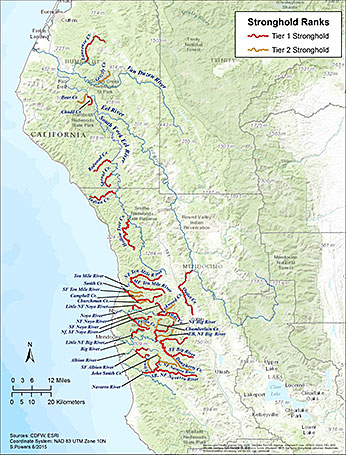(Humboldt and Mendocino counties)
Species / Location
 Figure 1. juvenile coho salmon. CDFW photo derek acomb.
Figure 1. juvenile coho salmon. CDFW photo derek acomb.
 Figure 4. California Department of Fish and Wildlife divers detecting and counting Coho salmon and steelhead trout. CDFW Photo Seth Ricker June 15, 2015, freshwater creek, humboldt county.
Figure 4. California Department of Fish and Wildlife divers detecting and counting Coho salmon and steelhead trout. CDFW Photo Seth Ricker June 15, 2015, freshwater creek, humboldt county.
 Figure 5. CDFW staff rescuing juvenile salmon from isolated and drying habitats. CDFW photo Tyler Brown, October 8, 2015, Olds Creek, tributary to the Noyo River, Mendocino County.
Figure 5. CDFW staff rescuing juvenile salmon from isolated and drying habitats. CDFW photo Tyler Brown, October 8, 2015, Olds Creek, tributary to the Noyo River, Mendocino County.
 Figure 6. releasing the rescued juvenile coho salmon from low water drought conditions into a cold-flowing stream. CDFW photo Jon Guczek, October 8, 2015, Noyo River Watershed, Mendocino County.
Figure 6. releasing the rescued juvenile coho salmon from low water drought conditions into a cold-flowing stream. CDFW photo Jon Guczek, October 8, 2015, Noyo River Watershed, Mendocino County.
drought has impacted populations of federally listed southern Oregon-Northern California Coho Salmon and Coastal California Coho Salmon in Humboldt and Mendocino Counties.
Need for Drought Stressor Monitoring
as the California drought extends into its fourth year, threatened and endangered populations of juvenile Coho salmon (figure 1) and steelhead trout are increasingly vulnerable during the summer when they are rearing. stream channel drying and elevated water temperatures can drastically reduce available habitat. because salmon and steelhead trout return from the ocean to the same streams to spawn in which they were born, local extirpation of existing stronghold populations likely will lead to long term population decline, potentially persisting long after drought conditions yield back to a wetter trend. while more local populations may vanish temporarily due to drought conditions, they can eventually re-establish themselves during better water years as long as core stronghold fish populations are maintained across the landscape. to best insure the ‘seed stock’ of our wildlife resources are kept intact through this difficult drought period, the California department of fish and wildlife (CDFW) has been monitoring key habitat and biological factors. drought monitoring has focused on the “last best habitats”, collecting real-time information on water quantity and quality, coupling this with biological surveys designed to evaluate salmonid population health (figure 2). this science-based strategy allows for informed management decisions and rapid response rescue operations (and /or other interventions applied) to be made strategically. additionally, to improve our understanding of drought impacts and wildlife needs beyond local watersheds, a water temperature transect was established along our major river systems in coastal northern California (figure 3).
 Figure 2. Map of Stronghold Coho Salmon Streams Monitored in Southern Humboldt and Mendocino Counties. PSMFC Sharon Powers.(click/tap to enlarge).
Figure 2. Map of Stronghold Coho Salmon Streams Monitored in Southern Humboldt and Mendocino Counties. PSMFC Sharon Powers.(click/tap to enlarge).
 Figure 3. Map depicting locations of water temperature monitoring sites in major river drainages in Northern California - CDFW Photo Justin. Garwood. (click/tap to enlarge).
Figure 3. Map depicting locations of water temperature monitoring sites in major river drainages in Northern California - CDFW Photo Justin. Garwood. (click/tap to enlarge).
Findings
CDFW staff conducted snorkel surveys in 16 streams (over 27 miles) of critical Coho salmon stream habitat during the summer of 2015 (figure 4). in addition to dives, CDFW staff recorded monthly stream flow and deployed temperature data loggers in 21 of these stronghold streams in Humboldt and Mendocino counties. by late august / early September, nearly 25% of the stream locations were documented to have dry reaches and only the deeper pools holding enough water to support fish. this data informed CDFW staff about the need to conduct a fish rescue on the Noyo river near Fort Bragg. as a result, CDFW crews were able to successfully rescue over 550 stranded Coho salmon and 207 steelhead trout from the last pools (figure 5) in Olds Creek (a stronghold tributary of the Noyo river) before the habitat completely dried, then fish were relocated to suitable habitat (figure 6) in another location within the same watershed. limiting fish relocations with the same watershed is an important tool for allowing fish populations to remain adapted and fit within local watersheds.
Future Efforts
as drought conditions continue across the state, sensitive and endangered salmonid populations must be managed in a strategic manner to conserve the species. collection of data before and after fish rescue is critical to inform whether and how to rescue fish. it also helps our understanding of the success of fish rescue operations. this science-driven process helps CDFW effectively protect and manage our natural resources. efforts like this project and others across California play a vital role in ensuring our valuable fisheries resources remain intact for future generation to enjoy.